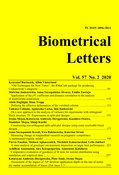
Biometrical Letters Vol. 57(2), 2020, pp. 237-251


The normal distribution is considered to be one of the most important distributions, with numerous applications in various fields, including the field of agricultural sciences. The purpose of this study is to evaluate the most popular normality tests, comparing the performance in terms of the size (type I error) and the power against a large spectrum of distributions with simulations for various sample sizes and significance levels, as well as through empirical data from agricultural experiments. The simulation results show that the power of all normality tests is low for small sample size, but as the sample size increases, the power increases as well. Also, the results show that the Shapiro–Wilk test is powerful over a wide range of alternative distributions and sample sizes and especially in asymmetric distributions. Moreover the D’Agostino–Pearson Omnibus test is powerful for small sample sizes against symmetric alternative distributions, while the same is true for the Kurtosis test for moderate and large sample sizes.

type I error, power, normality tests, normal and alternative distributions, simulation

